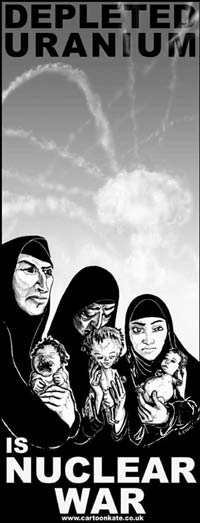![]()
Write us!
socialistviewpoint@pacbell.net
Sick Guard Members Blame Depleted Uranium
By Jane McHugh
 During war fighting, when the projectiles are fired or the plating blown up, DU particles become airborne, seep into the water and sink into the ground, entering the food chain. People ingest DU without even knowing it. Some veterans groups blame DU for Gulf War syndrome.
During war fighting, when the projectiles are fired or the plating blown up, DU particles become airborne, seep into the water and sink into the ground, entering the food chain. People ingest DU without even knowing it. Some veterans groups blame DU for Gulf War syndrome.
Headaches and joint aches, ever-present nausea, overpowering fatigue and pain when swallowing. Those are among the symptoms reported by a group of military police officers who were evacuated out of Iraq for other injuries, mostly orthopedic.
Must be radiation poisoning, the sick soldiers from the New York National Guard’s 442nd MP Company think.
The Army says that tests so far don’t support that, though medical experts continue to test 442nd soldiers.
“The Army basically said it was battle fatigue, that it was all in my head,” said Sgt. Agustin Matos of the 442nd, who is in medical hold at Fort Dix, N.J. He said he and three buddies tested for above-average levels of toxic depleted uranium.
Depleted uranium is formed when enriched uranium is separated from natural uranium in the making of fuel for nuclear reactors. The DU is recycled by the defense industry into anti-tank projectiles and tank armor plating.
During war fighting, when the projectiles are fired or the plating blown up, DU particles become airborne, seep into the water and sink into the ground, entering the food chain. People ingest DU without even knowing it.
Some veterans groups blame DU for Gulf War syndrome.
The 442nd, whose soldiers are mostly police officers, firefighters and prison guards from the New York City area, is supposed to report back to the Fort Dix demobilization station in a few weeks.
Because of the evacuated soldiers who have complained about DU-type symptoms, the entire company will be tested for radiation exposure upon arrival, said a senior Army physician who spoke on condition of anonymity.
Late last year, nine stateside “medical hold” soldiers in the 442nd were tested by one of the world’s preeminent authorities on nuclear medicine, Dr. Asaf Durakovic, who is on the staff at Georgetown University Medical School. Durakovic is an Army veteran of Operation Desert Shield and has worked at Veterans Affairs hospitals.
Durakovic couldn’t be reached for comment. But according to The New York Daily News, which hired him to do the testing, four of the nine, “almost certainly,” in Durakovic’s words, “inhaled radioactive dust, probably from exploded American shells made from DU.”
Matos was identified as one of the four. “Basically, it’s in our lungs and there’s no treatment. It’s almost like asbestos, there’s nothing you can do about it,” he told Army Times.
Sgt. Jerry Ojeda said he was one of the five who tested for “acceptable” levels of DU. Yet he said in a telephone interview that he feels sick, with tiredness during the day and sleeplessness at night, pounding headaches, body aches and lack of sex drive.
The Army physician said urine samples collected by the Army on April 2 will be tested at Walter Reed, the Army Center for Health Promotion and Preventive Medicine (CHPPM), and the Centers for Disease Control.
“These soldiers have a lot of medical concerns and we’re going to help them as best we can,” the doctor said. “But exposure to depleted uranium does not cause headaches, rashes, overactive bladder or anything like that. Uranium naturally occurs in the environment and every day you eat, drink and breathe it.”
The 442nd soldiers in medical hold were in Samawah, Diwanaya and Najaf. In Samawah last summer, they camped at a huge dilapidated train depot and train repair yard. Coalition soldiers from the Netherlands looking for a place to camp had measured “high levels of radioactive material” at the depot and moved far away from it, Ojeda said.
—The Army Times, April 16
Write us
socialistviewpoint@pacbell.net